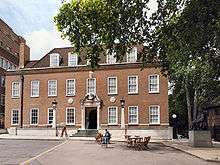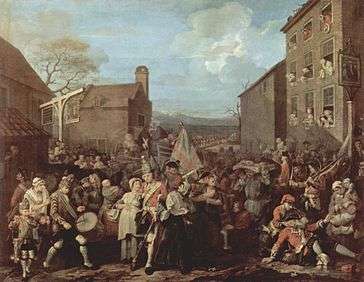Foundling Museum
 The museum's façade, Brunswick Square. A statue of Thomas Coram is to the far right. | |
 Location within Central London | |
| Established | 2004[1] |
|---|---|
| Location |
Brunswick Square London, WC1 United Kingdom |
| Coordinates | 51°31′31″N 0°07′18″W / 51.525278°N 0.121667°WCoordinates: 51°31′31″N 0°07′18″W / 51.525278°N 0.121667°W |
| Type | Art gallery, Memorial [1] |
| Visitors | c. 37,000 per year[2] |
| Director | Caro Howell[3] |
| Public transit access |
|
| Website | foundlingmuseum.org.uk |
The Foundling Museum in Brunswick Square, London tells the story of the Foundling Hospital, Britain's first home for abandoned children. The museum houses the nationally important Foundling Hospital Art Collection as well as the Gerald Coke Handel Collection, the world's greatest privately amassed collection of Handel memorabilia. After a major building refurbishment it reopened to the public in June 2004.
The museum examines the work of the Foundling Hospital's founder Thomas Coram, as well as the artist William Hogarth and the composer George Frideric Handel, both major benefactors of the institution. It also illustrates how the Foundling Hospital's charity work for children still carries on today through the child care organisation Coram.[4] It is a member of The London Museums of Health & Medicine group.[5]
History
The Foundling Hospital was commissioned by Thomas Coram in 1741. However in the early 1920s the trustees of the hospital decided to relocate operations to a modern purpose-built facility in Berkhamsted. In 1926, the land occupied by the former hospital in Bloomsbury was sold off. Between 1935 and 1937 the Thomas Coram Foundation (now known as Coram) built a new headquarters in Brunswick Square. The new building incorporated architectural features and original Rococo interiors from the original Foundling Hospital.[4]
The Foundling Museum was established a separate charitable organisation in 1998.[2] To safeguard the collection (over 100 paintings worth at least £30 million) a deal was agreed in 2002 under which Coram lent the pictures to the museum, allowing it to raise money to buy them over a 25-year period.[6]
The headquarters was refurbished between 2003 and 2004 by the architectural firm Jestico + Whiles.[7][6] In 2013 attorney general Dominic Grieve wrote to Coram stating that he was concerned that Coram’s "treatment of the museum … does not appear to fit with the spirit and intent of the arrangements put before the attorney general [in 2001]".[8] In 2012, it had 48,000 visitors.[6]
Collections
The Foundling Hospital Collection includes works of art by Britain's most prominent eighteenth-century artists: William Hogarth, Thomas Gainsborough, Joshua Reynolds, Louis-Francois Roubiliac and many others like Emma Brownlow. These paintings and sculptures, often donated by the artists themselves, were given in order to support this Britain's first home for abandoned children. These works effectively made the Foundling Hospital the nation's first art gallery available to the public.[4]
The museum also lets the visitor see furniture, photographs and other items from the days when the Foundling Hospital still accepted abandoned children to be reared and educated within its walls. Foundling tokens (coins, a button, jewelry, a poem) were given by mothers leaving their babies, allowing the Foundling Hospital to match a mother with her child should she ever come back to claim it. Sadly, the overwhelming majority of the children never saw their mothers again and their tokens are still in the care of the museum.[9]

The Committee Room, one of the original eighteenth-century interiors, is the room where mothers intending to leave their babies would be interviewed for suitability. It now houses several pictures and furniture, including Hogarth’s satirical and political March of the Guards to Finchley and a series of paintings by Emma King, depicting scenes from the lives of the children in the Foundling Hospital.[10]
The Picture Gallery is another original interior room. On the walls are paintings of governors and hospital officials through the ages. These portraits include Allan Ramsay’s portrait of Dr Richard Mead, Reynolds’s portrait of the Earl of Dartmouth, and Thomas Hudson’s portrait of the hospital’s architect, Theodore Jacobsen.[11]
The Court Room is where the Foundling Hospital’s Court of Governors used to meet. The room is a rococo ensemble of paintings, furniture and interior architecture, designed to make the best possible impression on all future potential governors and donors. The ceiling is a plaster work by William Wilton and paintings include Hogarth’s Moses before Pharaoh’s Daughter and Gainsborough’s picture of London’s Charter House.[12]
The uppermost floor of the Foundling Museum houses the Gerald Coke Handel Collection. An exhibition room presents Handel’s life and visitors can learn about his connection to the Foundling Hospital and see the testament he left behind. A fair copy of the Messiah, left to the Hospital at his death, is also displayed. Four armchairs with built-in speakers play Handel’s music.[13]
References
- 1 2 The Foundling Museum: About, ARTINFO, 2008, retrieved 2008-07-11
- 1 2 Charity Commission. Foundling Museum, registered charity no. 1071167.
- ↑ Official website of the Foundling Museum
- 1 2 3 The Foundling Museum Guide Book, Second edition, 2009
- ↑ "Medical Museums". medicalmuseums.org. Retrieved 26 August 2016.
- 1 2 3 Martin Bailey (30 September 2013), Art collection at stake in row between museum and charity Archived 3 October 2013 at the Wayback Machine. The Art Newspaper.
- ↑ "Jestico & Whiles update for university 'gateway'". Design Week. Retrieved 25 June 2018.
- ↑ Charlotte Higgins (23 June 2013), Row over sacking of Foundling Museum trustees The Guardian.
- ↑ "The Tokens". Foundling Museum. Retrieved 24 June 2018.
- ↑ "The Committee Room". Foundling Museum. Retrieved 24 June 2018.
- ↑ "The Picture Gallery". Foundling Museum. Retrieved 24 June 2018.
- ↑ "Court Room". Foundling Museum. Retrieved 24 June 2018.
- ↑ "Gerald Coke Handel Foundation". Foundling Museum. Retrieved 24 June 2018.
External links
| Wikimedia Commons has media related to Foundling Museum. |